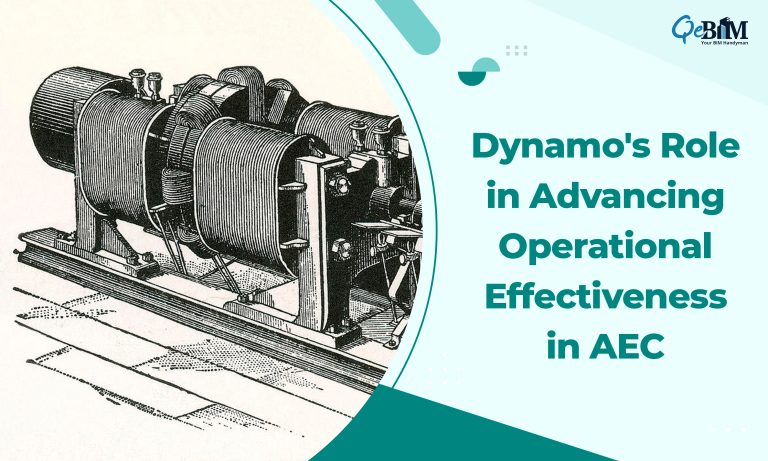Dynamo’s Role in Advancing Operational Effectiveness in AEC

In the Architecture, Engineering, and Construction industry, there exists significant variation in the proficiency with which companies carry out fundamental tasks. The adept execution of these tasks, surpassing the performance of competitors, is commonly referred to as operational effectiveness. Operational effectiveness is recognized for its role in enhancing productivity and profitability and therefore is of utmost importance to the industry. Despite the assertions that operational effectiveness differs fundamentally from and is not a substitute for a well-defined strategy, it remains crucial. If any company fails to master the foundational aspects of operations, the brilliance of its strategy becomes inconsequential.
Considering rapidly evolving AEC scenario, staying competitive and ahead of the curve is essential for businesses looking out for the operational excellence. One of the revolutionary tools that has been transforming the way professionals approach their work is Dynamo, developed by Autodesk.
What is Dynamo?
Dynamo, a visual programming language allows the architects, engineers, and designers to create complex designs and optimize workflows with unprecedented flexibility. It is a computational design platform that integrates with Revit, providing BIM Support. It enables users to craft personalized scripts or visual programs to automate repetitive tasks and generate complex geometric forms within Revit. It serves as a scripting interface that can be used to extend and enhance the capabilities of Revit Services.
In this blog post, we’ll explore how Dynamo is boosting operational effectiveness in the design and engineering sectors.
Dynamo: Transforming Operational Effectiveness in AEC Ventures
1) Streamlining Workflows:
Dynamo acts as a bridge between different design and engineering applications, allowing for seamless integration and data exchange. This interoperability is a game-changer, as it eliminates the necessity for manual processes, minimizing the risk of errors and saving valuable time. Dynamo streamlines workflows, allowing teams to concentrate on the creative aspects of their work instead of being hindered by tedious, repetitive tasks.
2) Parametric Design for Enhanced Creativity:
Parametric design, a key feature of Dynamo, empowers users to explore and manipulate design parameters in real-time. This flexibility fosters creativity and innovation, as designers can quickly iterate through various design possibilities without the need for extensive manual adjustments. Dynamo’s parametric capabilities enable architects and engineers to push the boundaries of traditional design, resulting in more efficient and aesthetically pleasing outcomes.
3) Automating Repetitive Tasks:
One of the major advantages of Dynamo is its ability to automate the monotonous and repetitive tasks that are inherent in the design and engineering process. By creating scripts and workflows, professionals can automate mundane and time-consuming tasks, freeing up their time for more critical, creative thinking. This not only improves the efficiency but also reduces the likelihood of errors associated with manual intervention.
4) Enhanced Collaboration:
Dynamo fosters collaboration by providing a common platform for designers, engineers, and other stakeholders to work together. Its visual programming interface makes it easier for team members with varying technical backgrounds to contribute to the design process. This cooperative approach guarantees that everyone involved in a project is on the same page, leading to smoother workflows and improved communication.
5) Data-Driven Decision Making:
Dynamo’s ability to handle vast amounts of data and generate complex visualizations empowers decision-makers with valuable insights. Designers and engineers can analyse data-driven visualizations to make crucial decisions, streamline and optimize designs, and pinpoint the potential challenges early in the process. This data-centric approach contributes to better-informed decision-making throughout the project lifecycle.
6) Customization for Unique Project Requirements:
Every design and engineering possess its own set of challenges and needs. Dynamo’s flexibility allows professionals to customize workflows and scripts to address specific project needs. This adaptability is invaluable in industries where no two projects are exactly alike, providing a tailored solution for each unique set of challenges.
7) Efficient Project Documentation:
Dynamo facilitates the generation of precise and detailed project documentation. With the ability to automate the creation of schedules, lists, and drawings, professionals can ensure that their designs are well-documented and meet industry standards. This not only saves lot in terms of time but also enhances the overall quality and completeness of project documentation.
8) Future-Proofing Workflows:
As technology continues to evolve, staying ahead of the curve and embracing the same is crucial for businesses. Dynamo, with its open-source nature and active community, ensures that users have access to the latest tools and innovations. This future-proofing aspect makes Dynamo a wise investment for businesses looking to adopt technologies that can adapt to emerging trends in design and engineering.
Conclusion:
Dynamo by Autodesk is undeniably a game-changer in the scenario of design and engineering. Its ability to streamline workflows, enhance creativity, automate tasks, foster collaboration, support data-driven decision-making, enable customization, facilitate efficient project documentation, and ensure future-proofing makes it an indispensable tool for professionals seeking to boost operational effectiveness. As businesses strive to stay competitive in AEC industry, Dynamo emerges as a catalyst for innovation, efficiency, and excellence in design and engineering processes.